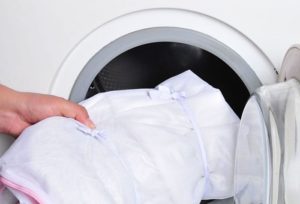 Organza is a transparent or translucent fabric made from polyester, silk or viscose fibers. It can be matte or glossy, with a pattern, applique or embroidery, and even with a perforated pattern. A popular material for sewing curtains, sometimes for making clothes (for example, evening dresses) and interior decoration. Hard to the touch, holds its shape.
Organza is a transparent or translucent fabric made from polyester, silk or viscose fibers. It can be matte or glossy, with a pattern, applique or embroidery, and even with a perforated pattern. A popular material for sewing curtains, sometimes for making clothes (for example, evening dresses) and interior decoration. Hard to the touch, holds its shape.
The process of washing organza curtains
If the curtains were purchased ready-made, you need to study the care instructions. As a rule, this fabric can be washed by hand and in an automatic machine with equal success.
Basic rules for washing organza products:
- completely dissolve the detergent at a temperature of approximately 40 °C;
- put the fabric in water for one hour;
- wash the product without stretching and avoiding aggressive spinning, otherwise the fragile structure of the fabric may be damaged;
- rinse the curtain in cool water at least twice, especially when using powder, so that no soapy streaks remain;
- gently squeeze or do without squeezing at all;
- hang the curtain to let the water drain out;
- hang the product to dry.
How to wash organza so it turns white: top 5 effective methods
 Curtains, among other things, act as a screen against street dust, so sometimes the product has to be bleached to remove stubborn stains.
Curtains, among other things, act as a screen against street dust, so sometimes the product has to be bleached to remove stubborn stains.
How to properly wash organza tulle
There are several effective and quite affordable methods of washing with bleaching:
- Add bleach that does not contain chlorine to the basin or washing machine, for example, a special product for delicate fabrics (with an oxygen-containing composition).
- Soak the product for 3-4 hours in a water-salt solution (at the rate of 2 tablespoons of ordinary salt per 10 liters of water), add detergent, wash and rinse.
- Wash the product in any way, then soak for several minutes in a solution prepared from 250 grams of starch, rinse again in fresh water. This method makes the curtains more resistant to dust.
- Stir approximately ten drops of brilliant green in a glass of water until completely dissolved without sediment, add the resulting liquid during the final rinse, leave the product for a few minutes, then squeeze lightly and hang.
- Wash in the usual way, add one capful of dye for bluing clothes during rinsing (not found in all stores today), stir, hold the fabric in the solution, and finally rinse.
To keep the product fresh longer, after bleaching, add one tablespoon of vinegar per liter of water during the final rinse. It is not recommended to iron organza bleached by one of these methods; the folds of the tulle should straighten out naturally.
Important! Before washing, tulle must be shaken to remove dust.
What's the best way to wash at home?
 Small tulle can be soaked in a basin. It is advisable to process and wash voluminous curtains in the bathroom.
Small tulle can be soaked in a basin. It is advisable to process and wash voluminous curtains in the bathroom.
Tulle in the kitchen, as a rule, absorbs all fats and strong odors. To wash the fabric from such contaminants, it is first soaked in a solution prepared from soda, salt and dishwashing liquid. The product should be left for 3-5 hours, then rinsed and only then washed.
How to hand wash without ironing
An organza product should not be washed too intensively, otherwise it will become wrinkled and creases will appear. If the composition allows, the not completely dry curtain can be hung back on the window and left in this state - it will straighten out under its own weight, eliminating the need for ironing. The dress should be hung on hangers to dry.
How to wash organza in a washing machine
To obtain the desired result, when washing organza curtains in a machine, the following conditions must be observed.
Gentle washing of organza in an automatic machine: which mode to choose
 It is recommended to soak the fabric before washing. Since it is thin, you need to select the delicate mode. It is advisable to disable automatic spin (at least it should not exceed 500 rpm). An additional rinse is recommended.
It is recommended to soak the fabric before washing. Since it is thin, you need to select the delicate mode. It is advisable to disable automatic spin (at least it should not exceed 500 rpm). An additional rinse is recommended.
Attention! It is advisable to place the product in a special bag for washing delicate items.
At what temperature should you wash organza?
Organza should be washed at a maximum temperature of 30–40 °C. If you set the temperature to a higher temperature, the fabric may become very wrinkled and will have to be ironed vigorously.
Suitable detergents
 You can use regular washing powder, but you will have to rinse the fabric several times. The best option is a liquid gel that does not leave streaks.It is also suitable for manual processing.
You can use regular washing powder, but you will have to rinse the fabric several times. The best option is a liquid gel that does not leave streaks.It is also suitable for manual processing.
Important! It is not advisable to use conditioner, otherwise the organza may turn yellow in the sun.
Is it possible to wash organza with embroidery?
Organza with embroidered and other decorative elements is washed exclusively by hand and with special care. This fabric can be soaked for a short time, but it is not advisable to bleach it.


 0
0





